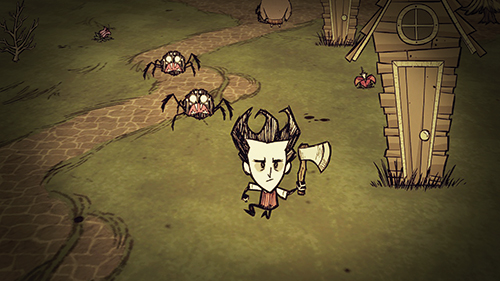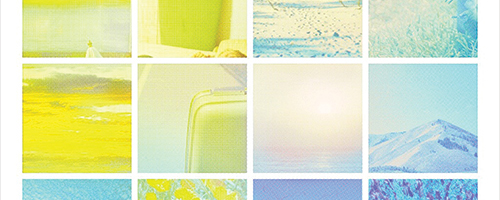In the recently released video game Don’t Starve you play the character Wilson, a gentleman scientist who wakes up stranded in a strange land inhabited by monsters. Your goal is threefold, the first of which is obvious: to not starve.
Indistinguishable from magic

In the recently released video game Don’t Starve you play the character Wilson, a gentleman scientist who wakes up stranded in a strange land inhabited by monsters. Your goal is threefold, the first of which is obvious: to not starve.
After that you’ll have to pay mind to your health and sanity, both of which will gradually drain over the course of the game. You’ll need to forage for food and use Wilson’s intellect to build crafting machines in order to survive.
But Don’t Starve isn’t just about you blissfully running around an alien countryside, collecting berries and making “the science.” Eventually night comes, and with it an unsettling darkness that seems, at first, to creep too close to your campfire.
As the days pass the seasons shift for the worse. It’s getting colder and the berries aren’t growing like they once did.
Your sanity is beginning to deplete more rapidly and the shadows around the fire are nightly pushing deeper into the protective ring of light. You see hungry eyes in the black abyss. You’ll soon begin to hear the voices.
You can prevent this, but it isn’t easy. To fend off the night and its unsavory influences you’ll need to build. Fire is of the utmost importance, but it’s also a fickle beast. Build your campfire too strong and too close to a forest, and you’re in for a light show that will also burn you to death.
But let’s take a step back. To get that firewood in the first place, you’re going to need to chop down some trees. You don’t have an ax, so you’ll have to make one from raw materials.
As you accumulate more raw materials, you might find you want to expand your building potential to better your mastery of this strange world.
Various crafting machines, both scientifically and magically oriented, can serve that purpose if you can find the time and materials to build them. The days are short and the key to success in Don’t Starve is balancing your daylight hours.
As a former Minecraft player, much of this came naturally to me, as the basic process of survival doesn’t differ much between the two games.
But if you haven’t already hopped on the open-world survival game zeitgeist by now, the first few hours might put you off.
It would be completely reasonable for a new player to wander off on the first day, gleefully chasing turkeys and rabbits, only to discover he is woefully unprepared for the night. Don’t Starve gives little in the way of a tutorial.
The game remaining relatively mum on its mechanics will be frustrating for some, but for others the process of discovery will be rewarding. While dying after having survived for 18 days will seem like a waste of time at first, it’s worth it to push through. There’s a bit more behind the curtain.
Death is part of the game and, in fact, failure yields reward. The longer you survive in each life the more XP (experience points) you gain, allowing you to level up and unlock new characters. Each unlocked character has their unique pitfalls and boons that I wouldn’t possibly consider spoiling.
Your XP and the levels you gain are unique in that they are the only things that carry over or accumulate between deaths. You lose all collected items upon death, adding a rogue-like element that is rarely enforced to such a degree within the genre.
With each death you gain something far more valuable than XP or items, though: you gain knowledge.
Knowledge is perhaps the true currency in Don’t Starve, as knowing something as simple as how to get charcoal, a key material in specific crafting recipes, can completely change the way you play the game the next time around.
Anyone familiar with developer Klei’s previous games, such as Shank and Mark of the Ninja, will know that the studio is no slouch in the visuals department.
Don’t Starve has a two-dimensional cut-out look that is reserved and defined, reminiscent of The Nightmare Before Christmas or The Melancholy Death of Oyster Boy-era Tim Burton illustrations.
Don’t Starve
Avaliable on PC, Steam, standalone via developer’s website, Chrome Web Store
$14.99
✭ ✭ ✭ ✭
That said, it’s not unreasonable to feel that more could be done visually with such a rich concept. There are moments when the barren nature of the world you are exploring works to the game’s advantage, but there are other times when the landscapes begin to feel repetitive.
Portland weather has been temperamental lately. One week it’s all sun and lying sleepily in the Park Blocks, and the next it’s the gloom and rain that we should all be used to by now.
Don’t Starve is the kind of game you can lose hours to on a rainy day, if only to marvel at the bizarre and alluring art style and dig deep into the game’s myriad mechanics.
Klei is also continuously updating the game: As of this writing, the next slated major update will reportedly include caves.
I don’t know what those caves will have in them, only that I will happily spelunk them and very likely freak out in the dark some more. Don’t Starve was a slow burn for me, but I’m hooked.






